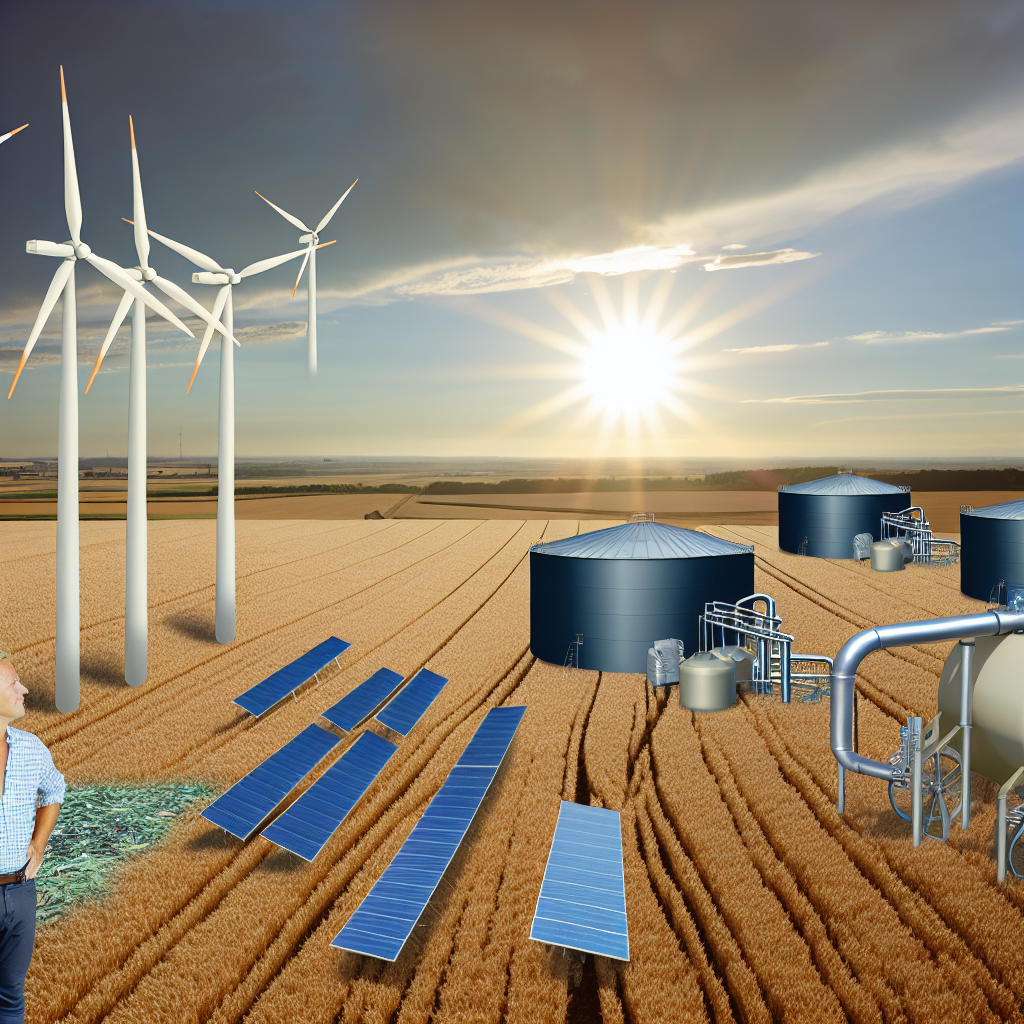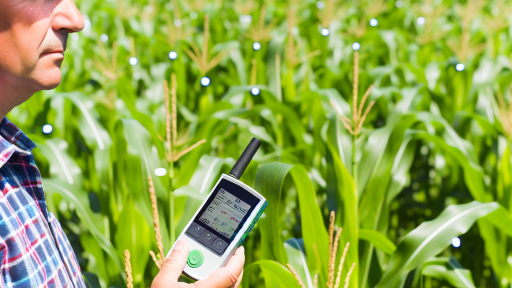Introduction to Renewable Energy in Agriculture
Integration of renewable energy is transforming agriculture.
Farmers increasingly seek sustainable options to power their operations.
Renewable energy offers numerous benefits, from environmental to economic.
For instance, solar and wind energy can significantly reduce costs.
Moreover, these sources contribute to decreased greenhouse gas emissions.
Renewable Energy Sources for Large-Scale Farms
Several renewable energy options are suitable for large-scale farms.
Solar panels provide a versatile energy solution for various farming needs.
Wind turbines harness natural wind currents, generating clean energy effectively.
Biogas production is another increasingly popular choice among farmers.
This method recycles agricultural waste, turning it into usable energy.
Benefits of Adopting Renewable Energy
Adopting renewable energy can enhance farm productivity.
Farmers often experience tangible economic benefits.
Cost savings from reduced energy bills can be substantial.
Furthermore, renewable energy increases energy independence for farms.
It also provides resilience against fluctuating fossil fuel prices.
Transform Your Agribusiness
Unlock your farm's potential with expert advice tailored to your needs. Get actionable steps that drive real results.
Get StartedChallenges and Considerations
Despite the benefits, challenges exist when integrating renewable energy.
Initial installation costs can be high for some renewable technologies.
Additionally, farmers may require specialized knowledge to operate these systems.
Therefore, support from government programs can be crucial.
Financial incentives can make this transition more feasible.
Case Studies of Successful Integration
Many farms have successfully integrated renewable energy solutions.
For example, Green Acres Farm has invested in solar energy.
This decision has drastically cut their electricity costs.
Similarly, Meadow Brook Farms uses wind turbines efficiently.
These innovations enhance their sustainability efforts while boosting profits.
Types of Renewable Energy Sources Suitable for Large-Scale Farms
Solar Energy
Solar energy serves as a powerful option for large-scale farms.
Photovoltaic (PV) panels can generate electricity from sunlight.
These installations can reduce dependence on fossil fuels.
Moreover, they can provide energy for irrigation and other operations.
Wind Energy
Wind energy represents another viable source of renewable power.
Tall wind turbines can harness strong winds prevalent in rural areas.
Farms can use wind energy to power machinery and facilities.
Additionally, wind farms generate income through energy sales.
Biomass Energy
Biomass energy utilizes organic materials for power generation.
Farms produce feedstock like crop residues and animal waste.
This process minimizes waste while providing an energy source.
Furthermore, biomass can mitigate greenhouse gas emissions.
Geothermal Energy
Geothermal energy taps into the Earth’s heat for efficiency.
This resource is especially advantageous in regions with geothermal activity.
Showcase Your Farming Business
Publish your professional farming services profile on our blog for a one-time fee of $200 and reach a dedicated audience of farmers and agribusiness owners.
Publish Your ProfileIt can provide heating for greenhouses and livestock facilities.
Also, it assists in maintaining optimal growing conditions.
Hydro Energy
Hydro energy harnesses water flow to generate electricity.
Farms adjacent to rivers can implement small-scale hydropower systems.
These systems can supply consistent energy for diverse farm needs.
Additionally, they contribute to sustainable water resource management.
Integrating Multiple Sources
Combining various renewable energy sources maximizes efficiency.
This multifaceted approach stabilizes energy supply and reduces costs.
Farmers can evaluate local conditions to determine the best mix.
Such strategies enhance resilience against market fluctuations.
Benefits of Integrating Renewable Energy into Farming Operations
Cost Reduction
Renewable energy sources significantly lower operational costs.
Farmers can rely less on traditional fuel options.
By harnessing solar panels, wind turbines, or biogas, farms save money.
These savings can be redirected to other areas of the farm.
Environmental Impact
Integrating renewable energy reduces greenhouse gas emissions.
This shift contributes positively towards fighting climate change.
Renewable energy also minimizes pollution associated with fossil fuels.
Ultimately, this supports healthier ecosystems for future generations.
Energy Independence
Utilizing renewable energy gives farms better energy security.
Farmers can become less reliant on external energy sources.
This independence ensures stability during energy price fluctuations.
Furthermore, energy independence enhances overall farm resilience.
Enhanced Brand Image
Adopting renewable practices improves a farm’s reputation.
Consumers increasingly favor environmentally-friendly products.
Consequently, farmers can attract a growing market segment.
Building a green brand fosters community support and loyalty.
Policy Incentives and Support
Many governments offer incentives for renewable energy adoption.
These may include tax credits, grants, or subsidies.
Such financial support offsets initial setup costs for farmers.
By leveraging these incentives, farms can enhance profitability.
You Might Also Like: Understanding CRISPR Technology In Agriculture
Challenges and Barriers to Adoption of Renewable Energy in Agriculture
Initial Investment Costs
Many farmers face substantial upfront costs when transitioning to renewable energy systems.
These costs include purchasing equipment and installing necessary technologies.
Accessing financing options can also be a challenge for some agricultural businesses.
Consequently, farmers may hesitate to invest in renewable energy solutions.
However, various grants and incentives exist to help offset these expenses.
Limited Knowledge and Training
A lack of awareness often hampers the adoption of renewable energy among farmers.
Many farmers are unfamiliar with available technologies and their benefits.
Moreover, appropriate training programs are often scarce or inaccessible.
As a result, farmers may feel overwhelmed by the complexity of renewable systems.
Showcase Your Farming Business
Publish your professional farming services profile on our blog for a one-time fee of $200 and reach a dedicated audience of farmers and agribusiness owners.
Publish Your ProfileIncreasing educational resources can bridge this knowledge gap and drive adoption.
Regulatory and Policy Barriers
Cumbersome regulations can impede the adoption of renewable energy in agriculture.
Farmers often encounter complex permitting processes for installation.
Additionally, some policies may favor traditional energy sources over renewables.
These obstacles create uncertainty for farmers considering renewable investments.
Advocating for streamlined processes and supportive policies can facilitate adoption.
Infrastructure Limitations
The existing infrastructure may not support large-scale renewable energy integration.
For instance, energy grids may require substantial upgrades to accommodate new sources.
In rural areas, the connectivity to energy markets can also be limited.
This lack of infrastructure can deter investment in renewable technologies.
Addressing these limitations is crucial to promoting widespread adoption in agriculture.
Market Fluctuations
Volatility in energy markets can deter farmers from investing in renewables.
Unpredictable energy prices may lead to hesitation in making long-term commitments.
Farmers often prioritize short-term stability over potential long-term gains.
Establishing contracts or partnerships can help mitigate these risks.
Securing stable pricing agreements provides farmers with greater confidence.
See Related Content: Advanced Soil Health Monitoring Technologies for Sustainable Agriculture
Case Studies of Successful Renewable Energy Integration on Farms
Solar Energy on Large Farms
Sunrise Meadows Farm in California utilizes solar panels to power its operations.
This innovative farm has significantly lowered its electricity costs.
Moreover, the excess energy produced is sold back to the grid.
Consequently, this model generates additional revenue for the farm.
Wind Energy Initiatives
Green Valley Farms in Texas has embraced wind energy effectively.
It installed several wind turbines across its expansive land.
These turbines now supply a substantial portion of the farm’s energy needs.
Furthermore, they help reduce the farm’s carbon footprint.
Biogas Production
Hillside Livestock Farm in Wisconsin has adopted biogas technology.
This farm converts waste materials into renewable energy.
The anaerobic digesters capture methane from manure.
As a result, the farm not only fuels its operations but also minimizes waste.
Hybrid Approaches
Sunny Acres Organic Farm integrates multiple renewable energy sources.
This farm combines solar, wind, and biogas for a robust energy system.
This strategy enhances energy reliability throughout varying conditions.
Importantly, it demonstrates the potential of hybrid systems for sustainability.
Community Involvement and Education
Maple Grove Farm actively involves the community in renewable energy projects.
It hosts workshops to educate local farmers on integrating renewable resources.
This initiative has sparked interest and cooperation among neighboring farms.
The impact is evident in increased adoption of sustainability practices.
Economic Benefits
These case studies highlight the economic advantages of renewable energy.
Farmers experience reduced energy costs and enhanced revenue streams.
Additionally, they benefit from government incentives promoting renewable energy use.
Showcase Your Farming Business
Publish your professional farming services profile on our blog for a one-time fee of $200 and reach a dedicated audience of farmers and agribusiness owners.
Publish Your ProfileUltimately, these practices contribute to both environmental and financial health.
Find Out More: Farm Management Software: Streamlining Daily Farming Operations

Financial Incentives and Grants for Farmers Utilizing Renewable Energy
Overview of Financial Incentives
Farmers can benefit significantly from financial incentives when adopting renewable energy technologies.
These incentives can lower upfront costs and improve project viability.
Government programs aim to increase the adoption of green technologies in agriculture.
Types of Incentives Available
There are various types of incentives available to farmers.
- Grants provide direct funds for renewable energy projects.
- Tax credits reduce the overall tax burden for eco-friendly investments.
- Subsidies lower the cost of renewable energy equipment.
Additionally, some local governments offer low-interest loans.
These loans can help farmers finance their renewable energy installations.
Federal Grants and Programs
The USDA offers several programs to support renewable energy use.
One prominent program is the Rural Energy for America Program (REAP).
REAP provides grants and loan guarantees for energy projects.
Farmers can apply for funding to install solar panels or wind turbines.
State-Level Incentives
Each state often has its own set of financial incentives.
For example, California has a robust rebate program for solar energy installations.
Similarly, New York offers various grants for renewable energy development.
Farmers should research state programs to maximize their benefits.
Maximizing Benefits Through Planning
Effective planning can enhance the financial benefits of renewable energy systems.
Farmers should evaluate which technologies best fit their needs.
Conducting an energy audit can identify potential savings.
Additionally, comparing different incentive programs is crucial.
Farmers can seek help from agricultural extension services for guidance.
Potential Challenges to Consider
Despite the benefits, farmers may face challenges when pursuing these incentives.
Complex application processes can deter participation.
Furthermore, funding availability may fluctuate based on government budgets.
Farmers should stay informed about changes in incentive programs.
Implications for Adopting Renewable Energy
Utilizing these financial incentives can significantly boost the transition to renewable energy.
Farmers who take advantage of these programs may see both economic and environmental benefits.
Investing in renewable energy not only contributes to sustainability but also enhances farm resilience.
See Related Content: Implementing Controlled Environment Agriculture on Your Farm
Technology and Innovations in Renewable Energy for Farming
Integrating Solar Power
Solar panels provide a powerful source of energy for farms.
They convert sunlight into electricity efficiently.
This technology reduces reliance on fossil fuels.
Farmers can install solar arrays on rooftops or open fields.
Additionally, some systems can track the sun for maximum efficiency.
Wind Energy Applications
Wind turbines harness the power of wind to generate electricity.
They can significantly lower energy costs for large-scale farms.
Installing a wind turbine requires an analysis of local wind patterns.
This technology complements solar power, providing energy in different seasons.
Utilizing Biomass Energy
Biomass energy uses organic materials to produce power.
This includes crops, animal waste, and food leftovers.
Showcase Your Farming Business
Publish your professional farming services profile on our blog for a one-time fee of $200 and reach a dedicated audience of farmers and agribusiness owners.
Publish Your ProfileFarmers can convert this waste into biogas through anaerobic digestion.
Biomass systems reduce waste while generating renewable energy.
Innovative Battery Storage Solutions
Energy storage systems are vital for using renewable energy effectively.
Batteries store excess energy generated during sunny or windy days.
This stored energy can power operations during low-production times.
Advanced battery technology makes it feasible for large-scale farms.
Smart Agriculture Technologies
Smart technologies optimize energy usage on farms.
These include IoT devices that monitor energy consumption patterns.
Data analytics help in making informed energy decisions.
By adopting smart farming solutions, efficiency improves significantly.
Government Incentives and Support
Governments worldwide promote renewable energy adoption.
Farmers may access grants or tax credits for sustainable practices.
Incentives reduce the upfront costs associated with new energy technologies.
Sharing success stories encourages more farmers to switch to renewables.
Examples of Successful Implementations
Several farms have successfully integrated renewable energy solutions.
The Thompson Family Farm relies on solar and biomass systems.
Similarly, Green Fields Estates employs wind turbines to boost energy efficiency.
These examples demonstrate the viability of renewable energy in agriculture.
Future Trends in Renewable Energy Adoption in Agriculture
Increasing Energy Efficiency
Farms are set to adopt more energy-efficient technologies in the coming years.
These technologies will reduce energy consumption significantly.
Moreover, farmers will invest in equipment that maximizes renewable energy use.
As a result, operational costs will decrease over time.
Enhanced Use of Solar Energy
Solar energy will become a primary source of power for large-scale farms.
Farmers will install solar panels on rooftops and unused land areas.
This shift will enable them to generate onsite energy.
Additionally, excess energy can be sold back to the grid.
Wind Energy Expansion
Wind energy adoption is set to rise in agricultural regions.
Farmers will invest in small wind turbines to supplement their energy needs.
These turbines will effectively harness local wind patterns.
Consequently, renewable energy integration will improve farm sustainability.
Innovative Energy Storage Solutions
Advancements in energy storage technology will bolster renewable energy adoption.
Battery systems will allow farms to store excess energy for later use.
This capability will enhance energy reliability during low production periods.
Farmers will benefit from reduced dependency on non-renewable energy sources.
Smart Farming Practices
Smart farming technologies will increasingly use renewable energy sources.
IoT devices will optimize energy usage throughout farming operations.
Data analytics will enable precise energy management and resource allocation.
Thus, farms will become more efficient and sustainable.
Government Incentives and Support
Government policies will encourage renewable energy investments in agriculture.
Subsidies and tax breaks will support farmers transitioning to renewables.
Showcase Your Farming Business
Publish your professional farming services profile on our blog for a one-time fee of $200 and reach a dedicated audience of farmers and agribusiness owners.
Publish Your ProfileAs a result, more farmers will consider renewable energy options.
This trend will contribute to a greener agricultural sector.
Additional Resources
New ERA Project Announcements | Rural Development
The 5 Cs of Agrivoltaic Success Factors in the United States …




